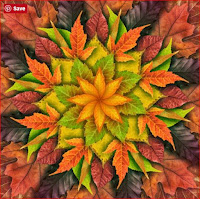Quilt No. 127
February 2019
Ah, the vibrancy of Africa. This quilt was a fun departure from the tediousness of my usual constructions. And it is very much a Gift from Africa, the fabric having been “gifted” three separate times.
It was first “gifted” to a friend of mine (Gift No. 1). She was given a large piece of
Veritable Real Java Print in the 1960's when she worked as a nurse in West Africa. She had stored it faithfully and carefully for many years, possibly with a twinge of guilt. If you don’t sew, how do you honor a large piece of exotic fabric? After fifty years there was still no answer to that question. When I asked her if she would care to contribute fabric to my
Tree of Life quilt, she thought of the African fabric, and gave me all two meters of it (Gift No. 2). After I made two leaves for the Tree of Life, there was still two meters of fabric remaining. It was in perfect condition, a testimony to the high quality and longevity of the cotton.
I felt that both she and the fabric deserved some kind of reward. I decided to make a lap sized quilt for her (Gift No. 3). For this this quilt, I used one of the large central motifs printed on the fabric, and added five borders on the sides, and four borders on the top/bottom. The vibrant green border fabric gives it a sort of "forest" feel, an almost organic
ooziness. For the flip side of the quilt I chose a serene white, to match her décor. During the machine quilting process, I matched the thread colour on the quilt top to the colour of the fabric. However, I kept the thread on the back of the quilt (the bobbin thread) white in case all that colour took her whole living room hostage. She could always display the calming white side of the quilt.
As I was working with it the fabric intrigued me so much that I wanted to learn more about it. It was obviously “African print fabric”, made in Africa, right? Wrong!
I discovered that, historically, most “African print fabric” was made in Europe. In present times it’s mostly made in India or China. So, in essence, the only thing “African” about it is the market in which it is sold.
Back in the 18th and 19th centuries Europeans were busy exploring the wonders of Indonesia. One of those wonders was the exquisite local wax print fabrics that were made in Java. Local artisans were very skilled in the technique of painting wax onto fabric to act as a “resist” when dyed. The fabric was painted/dyed in several sessions to achieve very detailed double-sided prints, a tradition likely borrowed from India. Excellent quality batik-style “wax prints” were the order of the day.
When the entrepreneurial Dutch discovered this fabric, they sniffed out a potential business opportunity. They carted the fabric back home. Surely with a little automation they could crank out this fabric more easily and more profitably! A bit of industrial tinkering ensued and they came up with a wax resin process, applying the resin mechanically with rollers. It looked a lot like the Indonesian fabric, but instead of being a true double-sided batik, the print was only one sided. It also had a less pristine more “crackled” appearance. Undaunted by their results, they sailed back to Indonesia, planning to undercut the fabric market.
Instantly, the Indonesians pooh-poohed this one-sided fabric. They weren’t buying it. The Dutch were stuck with the fabric. If they had been
Fabricland, they would have had to rid themselves of it in a buy-one-get-two-meters-free sale.
As happens with many adventures with new products, this wasn’t the end of it. As the Dutch sailed to and from Indonesia exchanging goods, they stopped to trade and resupply in West Africa. There was already a bit of a demand for the Javanese fabrics there. Locals had become familiar with them in the early- to mid-1800’s. Western African soldiers had been sent to fight in the Dutch East Indies. Upon return, they brought back Javanese fabrics for their wives. Locally, only a limited amount of fabric was being made, so new fabric was always welcome. The primed African market gushingly embraced the new fabrics the Dutch were offering. Gradually, these fabrics came to be known as “African print fabrics”. This planted the idea that the fabrics were African made. The Dutch happily forgot about their failed Indonesian marketing scheme and began designing fabrics that would appeal to African tastes. African print fabrics remain hugely popular today, and regardless of manufacturing origin, they are a joy to work with and to behold.
For more on the history on these fabrics, visit
Mazuri Designs.

































